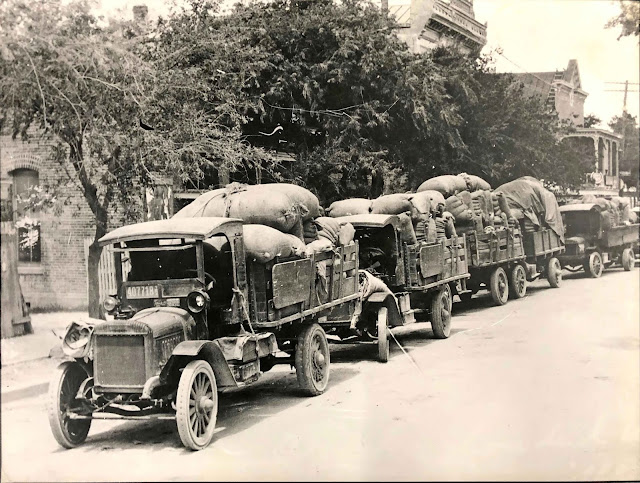 |
| Wool Trucks, 700 block of Water Street, downtown Kerrville, 1921. Photograph by Starr Bryden. Click on any image to enlarge. |
Last week, a long-time friend brought by two large photographs; one was of Pampell’s, and the other was of wool trucks parked in the 700 block of Water Street. I wrote about the Pampell’s photograph last week, and this week I’ll play detective with the wool truck photograph.
Here’s the thing about both of these images: I’ve published them before, but these prints are very large, so you can see lots of details. Plus, whoever made the prints did an excellent job, so they’re very sharp and clear.
Meaning, of course, there are lots of clues in these particular prints of these photos I haven’t been able to see before.
For instance, on the lead truck, I can see a little license plate under the windshield which clearly says 1921. That is probably an accurate clue as to the year this photograph was taken. I know this photograph, and one taken the same day, which shows the drivers standing next to their trucks, were both taken by Starr Bryden, who signed the photographs “Kodak Chap.”
To understand where this photograph was taken, the lead truck is parked in front of today’s Arcadia Live Theater, and the caboose truck is in front of today’s Humble Fork Restaurant (which is located in the historic Pampell’s building). The 700 block of Water Street is in between Sidney Baker and Earl Garrett streets; the trucks are facing southeast.
 |
| Taken the same day -- showing drivers. |
I’m hoping the Neunhoffer brothers can identify the make and year of at least the first truck.
How the trucks are rigged up is interesting, too. Did you notice the tires on that front truck? They look like a tread material has been nailed or bolted to an old wooden-spoke wheel.
The front truck also has a tarp rolled up and stowed on the front passenger-side fender, probably to protect the load of wool sacks in the truck bed. It looks like such a tarp has been deployed on the fourth truck, where its load of wool has been covered up.
Big wooden boxes are on the driver-side running boards, which I would assume held tools and other necessities.
The first and second truck also have a large flat wooden item – about the size of a table top – attached to the stakes along the truck bed. I don’t know what that object is – but it was probably important to the drivers and shearers in some way.
The big, pillow-shaped sacks in the back of the trucks probably contained wool, since that’s how Bryden labeled the photographs. But there’s always a chance some of the sacks contained mohair. Charles Schreiner had his two-story wool warehouse on that block of Water Street; it once stood about where the dining porch of Cartewheels Catering stands today, on the northeast side of Water Street.
Just like the wool wagons pulled by teams of mules which preceded these vehicles, these trucks are stacked high with wool sacks. It’s amazing those old trucks could haul that much weight over primitive hill country roads.
The trucks look like they’ve been though a lot of use and wear, though just making it to Kerrville from distant ranches west would have been quite an adventure.
A few weeks ago a customer stopped by the print shop to pick up a project we’d completed for him. He was headed to Rocksprings with a load of mohair, in large burlap sacks just like the ones in this photograph, and I went out to see them stacked in the back of his pickup. I’d seen a lot of similar items in historic photographs, but I’d never seen the actual item in real life. It was nice seeing a part of Kerr County history still in use today.
Until next week, all the best.
Joe Herring Jr. is a Kerrville native who, like most townies, has no idea how much hard work ranching really takes. This column originally appeared in the Kerrville Daily Times October 31, 2020.
Yep -- you can help produce this free newsletter by sharing it with someone. Sharing is certainly caring. (Buying one of my books helps, too!)


Interesting, as always!
ReplyDelete